

Stylistic Groups of the Coptic Textiles
Coptic textiles are distinguishable from earlier Egyptian textiles in that they do not use many of the well-defined motifs characteristic of Egyptian design. Coptic textiles do not use the lotus and papyrus motifs, nor do they feature the ancient style of figures with heads and limbs in profile view and torsos in frontal view. Instead, the stylized figures tend to be fully frontal as well as disproportionate, with short bodies and large heads.
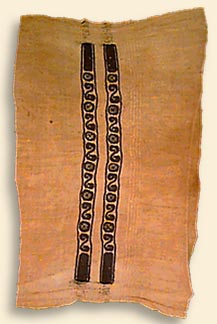
The earliest Coptic textile ornaments tend to be monochromatic geometrical designs, usually purple designs on a plain linen background. The textile ornaments are characterized by having mainly Classical/Hellenistic design motifs. The replacement of Egyptian design motifs with Classical motifs is due to the influential three hundred years of Greek rule under the Ptolemies. Monasteries and churches also utilized Hellenistic and Roman design elements in their sculptures and paintings.
Description: This tunic sleeve features two horizontal bands in dark purple on a tan ground which was originally white. The band have identical patterns of double-scroll motifs which alternate with roundels with rosettes. Materials/Construction: The ground is linen rep and the inserts are wool tapestry. Measurement: 22 x 34 cm. Date: Early fourth century. Accession number: CAS 0389-2402.
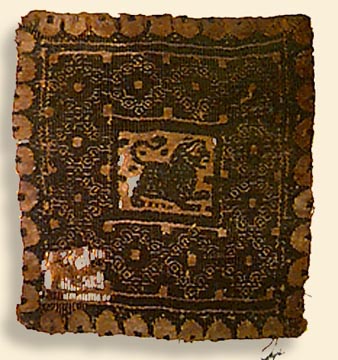
Some Egyptians had belief systems based upon the Greek myths as well, which also may explain the occurrence of Greek mythological themes. One mythological theme that was popular was that of Dionysus. The Cult of Dionysus had a following in Hellenistic Egypt, because Dionysus was easily identified with Osiris. Both Dionysus and Osiris had a godly father and an earthly mother. These similarities were also shared between Dionysus and Christ. The ivy and vine motif was symbolic of the cult of Dionysus, because he was the god of wine, and was also the Christian symbol of immortality.
Description: The brown ornament is on a beige ground. The edge of the ornament has a reverse scallop border. A lion is depicted in a small square in the center of the ornament, which is surrounded by a lozenge pattern. There are many symbolic meanings attached to lions. The lion is a pagan symbol of the Greek hero Herakles, and a Christian symbol of St. Mark, Evangelist. Materials/Construction: Wool and linen wefts on paired linen warps in a normal tapestry technique. Weft floats were used to indicate details. Measurement: 12.5 x 12 cm. Date: Early fifth century. Accession number: CAS 0389-2586.
Rectangle Cut from a Mantle (?)
CAS 0389-2376
Description: This rectangular piece of cloth features a dark purple eight-sided star on plain ground. The star motif was constructed from two overlapping squares. The part of the bottom square which is visible, the corners, contain a vine leaf pattern. The top square has a cable pattern border and a center roundel with a knot pattern. The inside corners of the square have ivy leaves in saffron and cream. From one corner of the star a rinceau band extends with a vase motif at the end. Materials/Construction: The ground is linen rep, the decoration is tapestry, wool and linen weft on grouped linen warps. The surface of the tapestry motif is ornamented in weft-float patterning carried out in two gauges of linen yarn. Measurement: 33 x 54 cm. Date: Fifth century. Accession number: CAS 0389-2376.
(Click on image to see detail.)
 In the fourth and fifth centuries, textiles began to show ornamental
variation including naturalistic representations of birds, flowers, fruits,
and mythological figures. Egyptian weavers studied in Persia during the Sassanian
kingdom, and brought back the motifs of opposing horsemen and facing peacocks.
This group of textiles show a wide variety of influences, including Byzantine
and Syrian. The Byzantine government repressed craftsmen, including weavers,
by controlling marriages, wages, and not allowing change of profession. Yet
despite of these harsh measures, the textile industry continued to prosper.
In the fourth and fifth centuries, textiles began to show ornamental
variation including naturalistic representations of birds, flowers, fruits,
and mythological figures. Egyptian weavers studied in Persia during the Sassanian
kingdom, and brought back the motifs of opposing horsemen and facing peacocks.
This group of textiles show a wide variety of influences, including Byzantine
and Syrian. The Byzantine government repressed craftsmen, including weavers,
by controlling marriages, wages, and not allowing change of profession. Yet
despite of these harsh measures, the textile industry continued to prosper.
Description: Each of the sleeve ornaments have two nearly identical bands. The bands feature brownish purple figures on a tan, originally white ground. At the top of each band, except the fourth, is a nude warrior with a shield, below which is a lion, portrayed at a right angle, and below the lion is a nude warrior with a raised left arm. In the fourth band the warriors are switched. From Shaikh Abada. Materials/Construction: The foundation is linen rep, the ornaments are tapestry, wool and linen on linen warp, with weft-float details. The ornaments are whip-stitched to the linen rep, indicated that the pieces were originally part of another garment. Measurement: A: 22 x 30 cm; B: 22 x 26 cm. Date: Sixth century. Accession number: CAS 0389-2408A,B.
Fragment of a Tapestry Square from a Cushion (?)
CAS 0389-2385
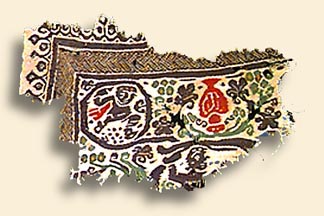
During the Byzantine period, monochrome textile ornaments continued to be used. These ornaments featured designs that represented figures as well as abstract designs. Beginning in the 6th century, multi-colored tapestries, which had previously only been used to decorate hangings, were used as ornaments on clothing. The textiles in this period are characterized by bold coloring and the abundance of small superfluous motifs. The figures tend to be more proportioned, with large eyes.
Description: This fragment is part of square motif with a border containing a braid motif, which encloses five roundels, one in the center and four in the corners. The central roundel possibly contained a centaur. The one extant corner roundel contains a male figure wearing a short cloak, possibly trampling purple grapes. To the right of this roundel is a vase overflowing with a grapevine. While some design elements are derived from Greek art, vintage scenes of grape crushing can be a symbol for the sacrifice of Jesus. The overflowing vase motif can signify a river of Paradise. Materials/Construction: This fragment was woven in the tapestry technique with wool and linen weft on wool warp. The details and the border pattern were worked in weft floats. Measurement: 9 x 14.5 cm. Date: Sixth century. Accession number: CAS 0389-2385.
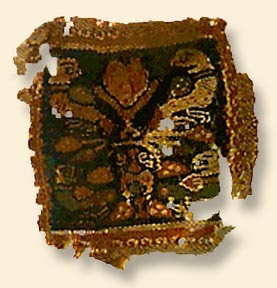
While there was a general set of motifs common to weavers, patrons could also apparently make requests for certain designs, which allowed them to make individualized personal statements.
At the end of the Byzantine era, Persians briefly ruled Egypt, and presented new designs like stylized plants and wing-like palmettes.
Description: This design is a Tree of Life motif. The ground is dark blue, there is a red border, and the center motif is composed of pink, green, and off-white. The tree of life motif is related to the Sassanian silk style. It symbolizes the garden of Eden as well as the crucifixion, indicated by the cross form of the tree. The doves symbolized deliverance and the Holy Ghost, and the peacocks symbolize immortality. Materials/Construction: The weave is tapestry, with wool warp, linen and wool weft. Measurement: 7 x 6.4 cm. Date: Sixth century. Accession number: CAS 0389-2388.

Description: In the center of this roundel is a mermaid holding
a conch shell, accompanied by a fish. The border is a stair-step jewel inlay
design. The colors are light brown, cream, black, dark yellow, dull red, dull
light green, and dull medium green. Materials/Construction: This is a tapestry
weave with wool and linen weft on two-ply Z-twist linen warp. Measurement: 8
x 7 cm. Date: Sixth or seventh century. Accession number: CAS 0389-2584.

After the Arabic conquest, the Copts continued to produce the same types of textiles. But the Arabs gradually took control of the textile industry as well as trade. The Arabs placed the Copts under harsher regulations which denied the Copts certain privileges and forced them to wear yellow or orange colored clothing to distinguish them. Women began to wear more clothing to cover their bodies more fully. Weavers worked under poor conditions, received low wages, and low status due to these governmental controls.
Description: The decorated red band had two borders on each side. The outer border has a row of tan equal-armed crosses, and the inner border has linked tricolor ivy leaves on a tan ground. The center of the band contains a procession of animals. Between each animal is a stylized plant motif. The animals and plants are in dull yellow, pink, light green, and medium green. The animal procession motif originated in the Near East and was used in Classical art as well. Materials/Construction: The fragment is made of wool, in a tapestry weave. Measurement: 13.7 x 32 cm. Date: Ninth or tenth century. Accession number: CAS 0389-2415.
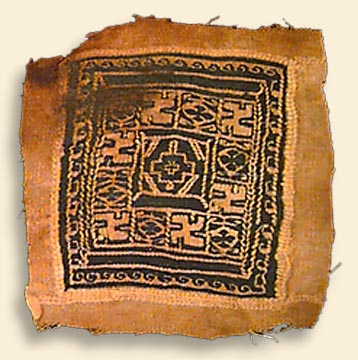
The Koranic intolerance of figurative images also influenced the weavers. As time passed, the Coptic textiles became less classical and more Arabic in design: they were more abstract, and there was less use of figures. Eventually, Egyptian textiles became completely Arabic in style.
Description: The ornament is dark blue with cream motifs, on a dark yellow ground. At the center of the ornament is an inconspicuous Greek (equal-armed) cross. Around the cross are twelve squares, containing hooked cross or a four-petaled rosette. The Christian motifs and the yellow ground of this textile indicate that it was probably worn by a Christian after the Arabs decided that Christians should wear distinctive clothing. Materials/Construction: This textile is made of wool, in a tapestry weave. Single rows of twining accentuate some of the straight lines of the design, and the whole ornament is edged by a double row of twining. Measurement: 14 x 14 cm. Date: Tenth century. Accession number: CAS 0389-2434.
Fragment of a Curtain with
a False Kufic Inscription
CAS 0389-2419
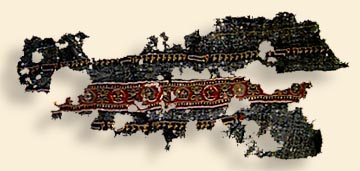
Description: The center of the fragment has a polychromatic band with bird, stars, animal head, building, and floral motifs. The band is surrounded by a dark blue background, with a row of meaningless Kufic letters. Real inscriptions began appearing in Arabic weaving in the tenth century. Materials/Construction: The textile is all wool, with the ground woven in tabby and the insert band in tapestry. Measurement: 17.5 x 41 cm. Date: Late tenth or early eleventh century. Accession number: CAS 0389-2419.
| Coptic Textiles Home | History of the Copts | Coptic Stylistic Groups | Coptic Weaving Technology |
| Coptic Textiles Collection | Resources | Online Exhibits Home | Anthropology Home |